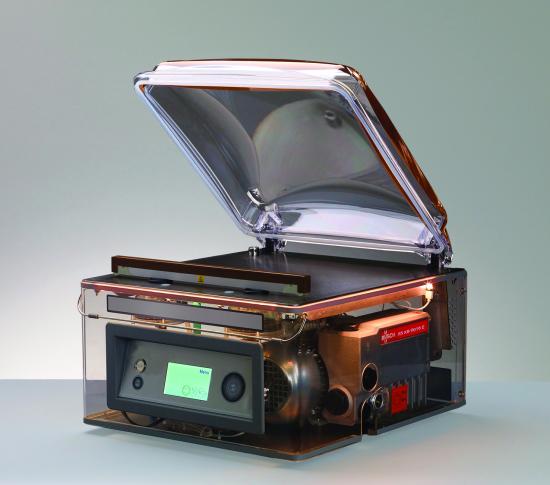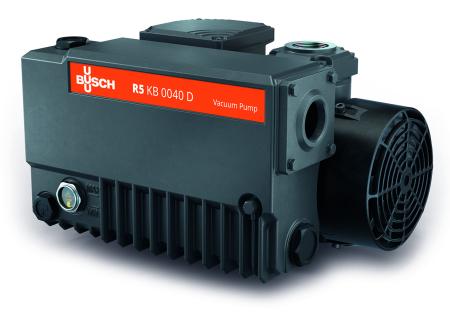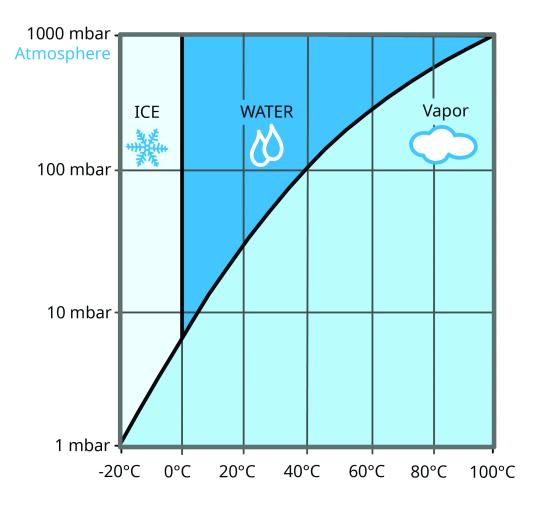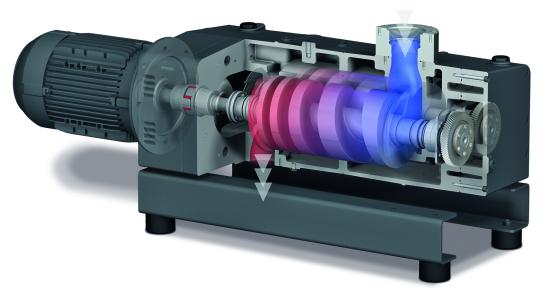
Figure 1. Functional model of a chamber packaging machine with visible rotary vane vacuum pump inside.
Case Study #1: Vacuuming of Fresh Food
Tips for correctly handling the vacuum pump in a chamber machine
Vacuuming fresh food using chamber machines is often a daily activity in butcher shops, at fresh food counters for meat, sausage, and cheese products, as well as in the foodservice industry. All fresh foods contain more or less unbound water, which partially evaporates during vacuum packaging. This can influence the quality of the product. Furthermore, if the packaging machine is not permanently in operation, the packaging result may deteriorate, or the packaging process may take too long. If the packaging process takes too long, the food to be packaged will lose weight. Below is an explanation of the physical operations performed during the packaging process, as well as some practical advice to ensure trouble-free operation and a long service life for the vacuum pump in the packaging machine.
R5 oil-lubricated rotary vane vacuum pumps from Busch Vacuum Solutions are standard (Fig. 1) in chamber machines and are used by all renowned manufacturers. They have been specially developed for packaging food and have proven themselves over decades. Through continuous advancement, these vacuum pumps have achieved the highest possible quality standard (Fig. 2).

Figure 2. Typical R5 rotary vane vacuum pump from Busch for use in chamber packaging machines.
Fresh foods such as meat, sausage, fish, and cheese are usually vacuum packaged at a pressure of around five millibars. At this pressure, the oxygen content in the remaining residual air is so minimal that the activity of various microorganisms is prevented. This significantly increases the shelf life of the packaged products. However, such low pressures also cause water to start evaporating at low temperatures. While water at normal atmospheric pressure only evaporates or begins to boil at a temperature above 100 degrees Celsius, at a pressure of 30 millibar it starts to evaporate at room temperature. At a pressure of 8 millibar, water evaporates already at a temperature of 4 degrees Celsius – even in cooled rooms (Fig. 3).
For this reason, fresh foods always generate water vapor during the packaging process, and this water needs to be extracted by the vacuum pump together with the air from the packaging chamber. If the vacuum pump rarely or never reaches the operating temperature due to very short runtimes, the water vapor condenses almost completely inside the pump. This leads to an accumulation of water in the interior and in the oil of the vacuum pump. This causes the oil to lose its lubricating and sealing function, which can have a negative effect on the performance and service life of the vacuum pump.

Figure 3. Change in the aggregate states of water as a function of temperature and pressure.
Recommendation for Operation
In order to ensure the reliable and trouble-free operation of chamber machines, the following should be observed:
1. Let the vacuum pump warm-up before packaging
To do this, simply run the packaging machine five to ten times without any product and packaging bag. Make sure that the chamber is dry for this.
2. Use the service program regularly
Nowadays, most chamber machines have a service program. This program ensures that condensed water vapor that has mixed with the oil is removed from the vacuum pump. This program should be started at least once a week. Depending on the packaging machine, it takes between 10 and 20 minutes. The vacuum pump is brought to operating temperature so that the water in the vacuum pump evaporates again and is discharged.
3. Check oil level and oil quality weekly
A visual inspection should be carried out once a week to check that the oil quantity and quality are correct. This can be done quickly and easily through the oil sight glass. The oil in the vacuum pump should be colorless to yellowish and clear. If the level falls below the MIN mark on the oil sight glass, the oil must be topped up. If the oil is milky and cloudy, this is a sign that water has mixed with the oil and formed an emulsion. The service program then needs to be run. If this has no effect on the visual condition of the oil, an oil change needs to be performed. Darkening of the oil is a sign that some substances, for example spices, have been deposited in the oil or that it has aged too much. An oil change also needs to be performed if this is the case.
4. Use suitable vacuum pump oils
The quality of the oil in vacuum pumps and the correct quantity play an important role in the packaging process and in protecting the pump. It is therefore essential to choose the correct oil to ensure the vacuum pump and thus the packaging machine function properly. Busch Vacuum Solutions has developed special oils for vacuum pumps in packaging machines. The VSA vacuum pump oil is suitable for packaging very moist products since it has been designed for the extraction of air with a high-water vapor level. For less moist food, the VSL vacuum pump oil can also be used. Both oils are food-grade synthetic oils with H1 approval. They also have a service life of up to four times longer than mineral oils. Busch also offers suitable oils for packaging with oxygen as a modified atmosphere.
5. Service your vacuum pump regularly
The vacuum pump in a chamber machine should be serviced regularly. The service intervals depend on the operating conditions, the number of packaging cycles, and the type of goods to be packaged.
A reliable indicator of when an oil change needs to be performed is the visual condition of the oil, as described under point 3.
When changing oil, the exhaust filter in the oil separator should always be replaced as well. For vacuum pumps with a pumping speed of 25 cubic meters per hour or more, the oil filter also needs to be changed. The sealing rings on the service openings should also be replaced in order to prevent leaks. For your convenience, Busch offers service kits for all R5 vacuum pumps, which contain all the necessary parts. Busch Vacuum Solutions offers worldwide maintenance service so that this work can also be carried out by a service technician directly at the customer's premises. Different types of service contracts are available.
Observing these instructions will help to ensure trouble-free operation and a long service life for the vacuum pump, as well as optimum packaging results.
Case Study #2: High-Quality Roof Tiles Thanks to State-of-the-Art Vacuum Technology
At the Wienerberger GmbH brick factory in Bad Neustadt, vacuum technology is used for degassing the clay mixture in the extrusion press. A vacuum system with a dry COBRA NX screw vacuum pump as the core element is being used for generating the necessary vacuum. This vacuum pump generates the vacuum needed without any oil and is completely contact-free. The variable speed drive enables demand-driven control and ensures that the desired vacuum can be precisely maintained independently of how much moisture the material contains. The modern vacuum system has provided Wienerberger with significant benefits when it comes to efficiency, quality, and operational safety.
The brick and tile factory in Bad Neustadt was founded in 1951 and was sold by the family company Gessner to Wienerberger Ziegelindustrie GmbH in 2001 to ensure the long-term success of the enterprise. In addition to Poroton backing bricks, the factory also produces highly efficient thermal insulation bricks in line with the requirements of new energy-saving regulations. Wienerberger Ziegelindustrie GmbH, headquartered in Hanover, Germany, is part of Wienerberger AG, an internationally active group with its head office in Vienna, Austria.
An extrusion press is used to manufacture various Poroton backing bricks. The material is degassed as it passes through the vacuum chamber between the twin-shaft mixer and the extrusion press. This prevents air pockets during extrusion and thus guarantees pore-free castings. This also significantly increases their stability, preventing them from deforming before they dry and ensuring dimensional accuracy of the finished brick. The porosity necessary for good thermal insulation properties after they are fired is ensured using supplemental materials such as sawdust, paper pulp, and polystyrene. These burn away during the firing process, leaving pores in the material.
Poroton backing bricks are manufactured at the Wienerberger brick factory in Bad Neustadt, Germany.
Previously used vacuum supply required high maintenance effort
In earlier years, the Wienerberger brick factory in Bad Neustadt used a once-through oil-lubricated rotary vane vacuum pump. When the previously used vacuum pump needed a general overhaul, plant manager Wolfram Tittel began to search for ways to optimize his vacuum supply. His primary goal was to minimize oil consumption, the accumulation of oil emulsion, and maintenance efforts. So he spoke with the vacuum specialists from Busch Vacuum Solutions, who performed a detailed analysis of this application and then suggested a completely new overall solution for vacuum generation.
Busch develops a clay degassing system for the highest level of operational safety
Busch developed a clay degassing system specifically for this purpose. At its core is a COBRA NX screw vacuum pump, which is used to extract air and water vapor, and compress and expel them again completely dry, i.e. without the use of oil or any other operating fluids. The standing filter upstream of the vacuum pump has been optimized for dust and particles from clay and loam masses. The frequency-controlled motor of the vacuum pump and the integrated demand-driven control unit make it possible to precisely maintain the defined vacuum level in the vacuum chamber. Due to its design, this vacuum pump can consistently maintain the prescribed vacuum levels between one millibar and atmospheric pressure throughout the whole process.
Depending on the level of moisture in the clay mixture, there are varying levels of water vapor that need to be extracted from the vacuum chamber. This means that the pumping speed of the vacuum pump has to be increased via a higher motor frequency for very moist material because, in addition to the actual evacuation of air, higher amounts of water vapor also need to be suctioned out. If the material contains less moisture, the pumping speed can be reduced again. As a result, the vacuum level in the vacuum chamber remains constant at all times. In addition, the desired moisture level between 19.5% and 21.5% can be precisely maintained when the material is pressed into the nose piece during extrusion. This ensures a high level of operational safety during the clay degassing process while maintaining flexible process conditions.
COBRA NX vacuum system for degassing clay bricks at Wienerberger.
The vacuum specialists from Busch dismantled the COBRA vacuum pump used after one year of running time in the manufacturing plant and examined it thoroughly. They did not find any damage or signs of wear and tear from dust or particles penetrating the vacuum pump. The maintenance work is significantly less than that required for an oil-lubricated vacuum pump. Thanks to the contact-free operating principle of the COBRA screw vacuum pump, there is no wear, thus no wearing parts need to be replaced. The oil-free operation also eliminates the previous necessary oil filter changes. In addition, all work and costs for procuring the oil and disposing of the oil emulsion have also become unnecessary.
Enormous energy and water savings
As a brick factory whose energy management complies with the DIN 50001 standard, the possibility of reducing energy consumption for vacuum generation was of great significance. The newly deployed vacuum pump usually operates in a range from 30 to 35 Hertz and only operates at full load when the water vapor level is very high.

Operating principle of a COBRA NX screw vacuum pump.
About Busch Vacuum Pumps and Systems
Busch Vacuum Pumps and Systems is one of the largest manufacturers of vacuum pumps, blowers and compressors in the world. Our products are at the forefront of vacuum and low-pressure technology. For more information, visit www.buschvacuum.com.
All images courtesy of Busch Vacuum Pumps and Systems.
For similar articles on Industrial Vacuum in Food Applications, visit https://www.blowervacuumbestpractices.com/industries/food.
Visit our Webinar Archives to listen to expert presentations on Industrial Vacuum Technology at https://www.blowervacuumbestpractices.com/magazine/webinars.



